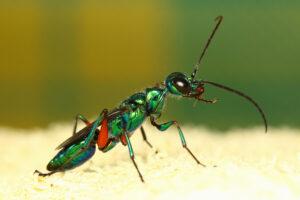Emerald Cockroach Wasp (Ampulex compressa)
Updated on
28/10/2022
Emerald cockroach wasps are the sole members of the family Ampulicidae. The jewel-like shine and color on its body give the insect its other name, the jewel wasp. They are parasitic, killing cockroaches and using their body as a host to feed their larvae.
Scientific Classification
- Class:Insecta
- Order:Hymenoptera
- Family:Ampulicidae
- Genus:Ampulex
- Species:A. compressa
Conservation Status
Description and Identification
The females are about 0.86 inches (22mm) in size. Males tend to be smaller by almost half the size.
The wasp has a shiny, metallic blue-green exoskeleton. The second and third pair of legs in the wasp appear red, particularly in the region around their thighs.. The females have a stinger—a modified egg-laying body part called an ovipositor. Stingers are absent in males.
Jewel wasps have two spines at the top of the tibia bone in their middle leg. The jugal(base) lobe of the hind wings is very small or absent in this species.

Distribution: Tropical regions of South Asia and Southeast Asia; Pacific Islands; Africa; South America: Coastal parts of Rio de Janeiro and Santos of Brazil
Habitat: Tropical regions and warm climates with over 50% humidity
Do They Bite/Sting: No. They use their sting to paralyze their host cockroaches.
Lifespan: Several months
Predators: Birds and mantises
Behavior and Characteristics
Reproductive Behavior
The female wasp finds a target host – the American cockroach and immobilizes it through two separate venomous stings.
The first sting is delivered to the mass of nerve tissue in the cockroach, paralyzing its front legs for around 2-3 minutes.
The stinger consists of γ amino-butyric acid (GABA), taurine, and beta-alanine. When this venom affects the roach, the chloride channels in its body are activated, resulting in paralysis. The beta-alanine further extends the paralysis period.
This combination of compounds prevents the cockroach from defending itself and stops any movement. The wasp takes this opportunity to inject its second sting, or rather a series of them one after the other.
The second sting administered by the wasp is very precise. It is aimed at the subesophageal ganglion (SEG) of the head area of the cockroach.
The neurological transmitter called octopamine, which controls muscle contraction in sudden movements in the cockroach’s body, gets limited after the second sting.
Mind Controlling the Prey
After being stung by the wasp, the injected venom makes the cockroach feel enslaved, and it moves sluggishly as if mind controlled.
The antennae of the newly incapacitated host are then half chewed off by the wasp, and it consumes the roach’s hemolymph(body fluids). The victim is then led towards the wasp’s burrow when the latter gets at its prey by pulling it by its remaining antennae parts. The cockroach becomes very submissive, as if it was mind-controlled.
Life Cycle
The wasp lays one to two white eggs(about 2mm long) between the roach’s mesothoracic legs. With its escape reflex shut down, the cockroach becomes a lazy and compliant living ‘zombie’ host, fed on by the wasp’s offspring.
Three days after oviposition, when the first instar larva emerges after hatching, it pierces the soft cockroach cuticle to feed on hemolymph for 4–5 days.
The larva continues to feed through the second instar, after which it moves into the cockroach’s body and feeds on its internal organs. This stage lasts for about eight days as the larva prepares for pupation. A multilayered spindle-shaped silken cocoon, thick, and chocolate-colored, gets spun out by the larva. This pupation takes several weeks.
Finally, a fully grown adult wasp emerges from the hollow body of the cockroach and completes the life cycle.
FAQs
Ans. The process by which the egg develops in the cockroaches is very unhygienic. The decomposing roaches are a host of harmful pathogens. Proper hygiene and sanitization are required to prevent any chance of infestation.
Source
img.freepik.com, live.staticflickr.com, media.kidadl.com, lh3.ggpht.com










